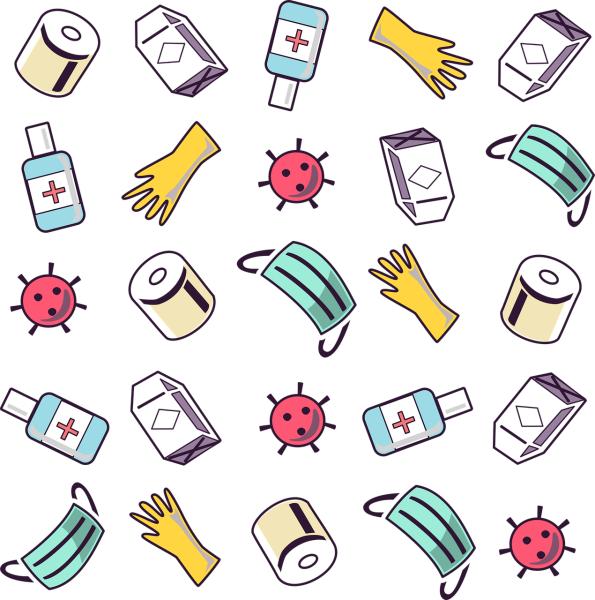Before we jump in, a bit of demographic housekeeping. The survey made use of Pew’s ongoing American Trends Panel (ATP), an online survey panel that is recruited through national, random sampling of residential addresses" – weighted to reflect America. [1]
What Virus? At this juncture, 54% of adults know someone hospitalized or who has died from COVID-19.

 What risk? The evaluation of our risk seems to follow what has been published in the media except that men are more susceptible than women but feel less risk – perhaps real men aren't concerned about being sick. As you might expect, Republicans, too, feel they are immune, and if you are one of the half of Americans who know of COVID-19's effects personally, you are 12% more inclined to feel "at- risk" yourself.
What risk? The evaluation of our risk seems to follow what has been published in the media except that men are more susceptible than women but feel less risk – perhaps real men aren't concerned about being sick. As you might expect, Republicans, too, feel they are immune, and if you are one of the half of Americans who know of COVID-19's effects personally, you are 12% more inclined to feel "at- risk" yourself.

No, I'll wait, you can go first. It turns out that all of those articles about who should be first in line for a vaccine may have missed a nuanced concern. Perhaps the real question is not who gets to go first, but who has to go first. You would hope that healthcare workers, the most exposed and the most versed in the science of vaccinations, will prove to be good role models for the rest of us.

Surely, an understanding of vaccine science will come to our rescue. Not so fast on a belief that education and role models and that presumably includes Presidents, will help. Look at the nearly 19% who are pretty certain not to get the vaccine once others start getting it, and there is more information. It is hard to identify a comparative number, but roughly 2% of eligible children in the US are not vaccinated, nowhere near that 19%. On the other hand, nearly half of the eligible individuals got a seasonal flu vaccine in 2018-2019. And just as we see for a COVID- 19 vaccine, Black Americans were more vaccine-hesitant than any other groups for seasonal flu vaccination.
 An abundance of caution The more significant the perceived risk and the greater the trust in the process of development and approval, the more likely to get vaccinated. Our previous actions are good predictors of our future ones. Those who get seasonal flu vaccines are lining up for the COVID-19 vaccines.
An abundance of caution The more significant the perceived risk and the greater the trust in the process of development and approval, the more likely to get vaccinated. Our previous actions are good predictors of our future ones. Those who get seasonal flu vaccines are lining up for the COVID-19 vaccines.
 Who do you trust?
Who do you trust?
Over time medical scientists and scientists, in general, are becoming more trustworthy. Journalists have seen a decline in the last two years. Is this a "shoot the messenger" problem?
The rest have remained about the same. We trust our military, less so, our school principals and religious leaders. Business leaders and elected officials are fighting over last place.
 The Tradeoff – Do we want health or wealth? That is the real question behind the Great Barrington Declaration and all the other fights about lockdowns or other changes to our behavior. While there is a significant political divide over what is best for our health, we all recognize that lockdowns are killing our individual and collective economies.
The Tradeoff – Do we want health or wealth? That is the real question behind the Great Barrington Declaration and all the other fights about lockdowns or other changes to our behavior. While there is a significant political divide over what is best for our health, we all recognize that lockdowns are killing our individual and collective economies.
 A Guide to Social Distancing First, I have added those red arrows to clarify. I also thought that we could better visualize the results with the line graph, based on the same numbers.
A Guide to Social Distancing First, I have added those red arrows to clarify. I also thought that we could better visualize the results with the line graph, based on the same numbers.
Our behavior is predicated upon our perceived risk of getting COVID-19 and the risk of exposure or transmission in the proposed activity. Most of us will go to a grocery store; far fewer will attend a crowded indoor event.
 We usually would end by adding our thoughts. But I find the data and its visualization compelling on their own. OK, I can't help but say one thing. The media only shared the top number, 60% of Americans willing to consider vaccination now. But there is a lot more to be learned taking a deeper dive into the data. That is one of our missions at the American Council on Science and Health, to bring you not just the lead, but the nuance – to be a fair witness.
We usually would end by adding our thoughts. But I find the data and its visualization compelling on their own. OK, I can't help but say one thing. The media only shared the top number, 60% of Americans willing to consider vaccination now. But there is a lot more to be learned taking a deeper dive into the data. That is one of our missions at the American Council on Science and Health, to bring you not just the lead, but the nuance – to be a fair witness.
[1] Here is the breakdown of the unweighted sample

Source: "Intent to Get a COVID-1g Vaccine Rises to 60% as Confidence in Research and Development Process Increase“ Pew Research Center December 2020




